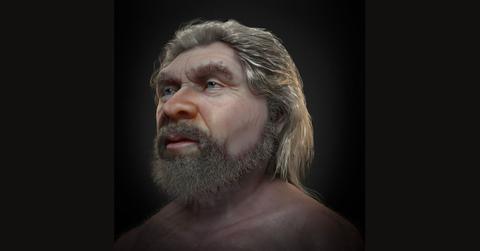Unveiled: ‘Strong and Serene’ Face of First Human on Earth 300,000 Years Ago

Researchers previously discovered that Neanderthals carried three viruses that still affect humans today.
A Brazilian designer has created a three-dimensional image of what the first human might have looked like 300,000 years ago.
Knewz.com reported that Cícero Moraes utilized information from the Max Planck Institute, combining it with features of contemporary humans to produce a face that appears "strong and serene."
Moraes based his reconstruction on a skull found at the Moroccan Jebel Irhoud site in 2017. This discovery challenged the previously held belief that the first humans originated in East Africa 200,000 years ago.
Moraes explained his process: “Initially, I scanned the skull in 3D, using data provided by the researchers of Max Planck Institute. Then I proceeded with the facial approximation, which consisted of crossing different approaches, such as anatomical deformation,” Pen News reported.
He detailed further: “This is where the tomography [the imaging of cross-sections using X-rays or ultrasound] of a modern human [head] is used, adapting it so that the donor’s skull becomes the Jebel Irhoud skull and the deformation ends up generating a compatible face.”
Moraes noted that he reconstructed a male face due to the robust nature of the archaic skull, which is composed of more than one piece. The images can be seen here.
Describing the Jebel Irhoud artifact as “excellent and quite coherent, anatomically speaking,” Moraes, who also teaches and produces veterinary prosthetics, mentioned being reminded of another skull from Israel, named Skhul V, which dates back 120,000 years.
“The Jebel Irhoud skull is very similar to Skhul V, another archaic Homo sapiens,” he explained. “However, it also has some characteristics that are compatible with Neanderthals [early humans believed to have lived in Eurasia until 40,000 years ago] or Heidelbergensis [an era between 781,000 to 126,000 ago].”
- What Lies Beneath: NASA Scientist Believes Aliens May Have Found 'Perfect' Hiding Spot in Earth's Oceans
- Global Threat: Russia Insider Warns West of 'World War Using Nuclear Weapons' Amid Escalating Support for Ukraine
- Countdown to Disaster? Ex-NATO Official Warns Russia, Iran and China Could Wage WWIII in Just Years
Moraes created a series of approximations in didactic images, resulting in two sets of images: one objective, with more technical elements, and another artistic, with skin and hair pigmentation.
He highlighted the significance of the digitally resurrected human, stating, “What caught the most attention in relation to Jebel Irhoud is that this discovery placed our species in a historical time 100,000 years earlier than previously imagined.”
Never miss a story — sign up for the Front Page Detectives newsletter. Be on the scene the moment news breaks.
The Jebel Irhoud skull, dating to approximately 315,000 years ago, is currently the oldest known Homo sapiens. The second oldest, found at Omo Kibish in Ethiopia, dates to 195,000 years ago.
Jean-Jacques Hublin, a palaeoanthropologist at the Max Planck Institute, confirmed the age of the Jebel Irhoud skull at the time of its discovery, stating: “We used to think that there was a cradle of mankind 200,000 years ago in East Africa. But our new data reveals that Homo sapiens spread across the entire African continent around 300,000 years ago.”
Become a Front Page Detective
Sign up to receive breaking
Front Page Detectives
news and exclusive investigations.
